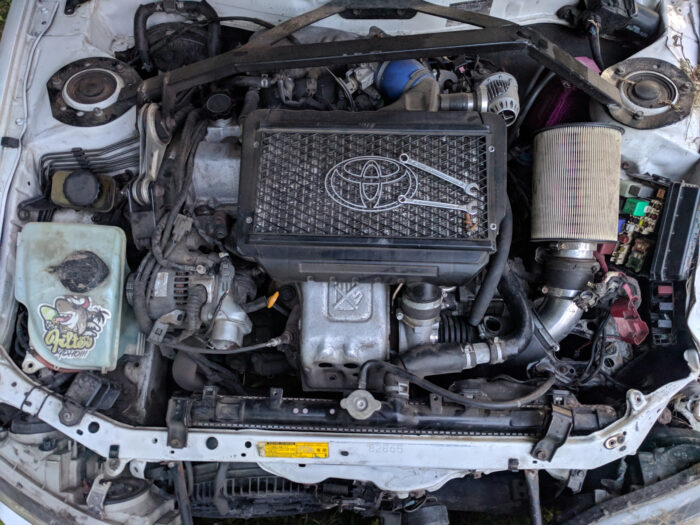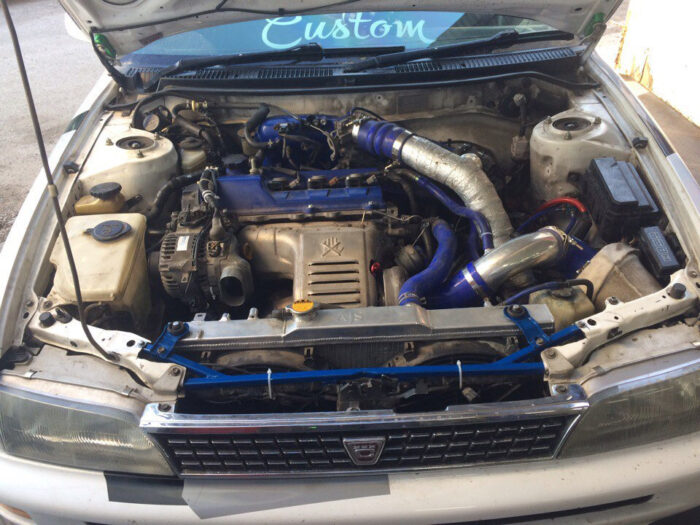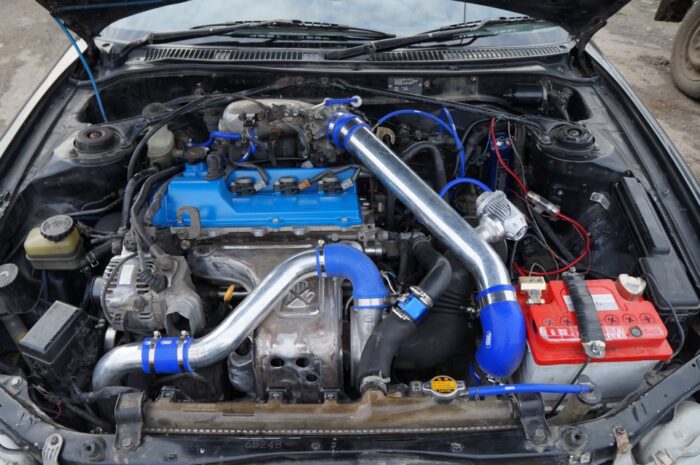The Toyota 3S-GTE engine is a turbocharged, four-cylinder, 2.0-liter engine produced by Toyota. It is part of the S engine series and was first introduced in 1986. The “GTE” in its name stands for “Grand Touring Engine”.
The 3S-GTE engine is known for its performance capabilities and was used in a variety of Toyota models including the Celica, MR2, and Caldina. It features a turbocharger that boosts power output and a four-valve-per-cylinder DOHC (dual overhead cam) design that allows for high-revving performance.
The engine was produced in multiple generations, with each generation featuring improvements to power output, torque delivery, and overall performance. Some later models of the 3S-GTE engine also featured advanced technology such as variable valve timing and electronic fuel injection.
The maximum power output of the 3S-GTE engine varies depending on the specific model and year, but it typically ranges from 200 to 260 horsepower, with torque output ranging from 200 to 273 lb-ft. The engine is known for its reliability and durability, and with proper maintenance, it can last for many years.
Engine specifications for Toyota 3S-GTE 2.0
1, 2 generations
| Configuration | Inline |
| Number of cylinders | 4 |
| Number of valves | 16 |
| Displacement | 1998 cc |
| Cylinder diameter | 86 mm |
| Stroke | 86 mm |
| Power system | Injector |
| Engine power | 185 – 235 hp |
| Torque | 250 – 305 Nm |
| Compression ratio | 8.5 – 8.8 |
| Fuel type | Medium/Plus |
| Euro class | EURO 2 |
3, 4 generations
| Configuration | Inline |
| Number of cylinders | 4 |
| Number of valves | 16 |
| Displacement | 1998 cc |
| Cylinder diameter | 86 mm |
| Stroke | 86 mm |
| Power system | Injector |
| Engine power | 245 – 260 hp |
| Torque | 300 – 325 Nm |
| Compression ratio | 8.5 – 9.0 |
| Fuel type | Premium, Supreme |
| Euro class | EURO 3 |
Weight of the Toyota 3S-GTE
| Modification | Weight (lbs) |
|---|---|
| Stock 3S-GTE engine | 396-440 |
| Lightweight flywheel | -5 to -10 |
| Aftermarket turbo kit | +20 to +50 |
| Forged pistons and rods | +5 to +10 |
| Ported and polished head | -5 to +5 |
| Aftermarket intake manifold | +5 to +10 |
| Aftermarket exhaust system | -5 to -10 |
It’s important to note that these weights are for reference only and can vary depending on the specific modifications and components used. Additionally, the weight of the engine can be influenced by factors such as accessories, exhaust system, and transmission. These weights are for the engine alone and do not include any additional components such as the transmission or exhaust system. It’s also worth noting that while some modifications may increase power output, they can also increase weight and potentially impact overall performance.

The Toyota 3S-GTE generations
The Toyota 3S-GTE engine has been produced in multiple generations and has been the subject of many modifications by enthusiasts seeking to improve its performance. Here’s a breakdown of the different generations and popular modifications:
1st Generation (1986-1989):
- Produced for the Toyota Celica GT-Four (ST165)
- Turbocharged with a maximum power output of 190 horsepower
- Popular modifications include upgrading the turbocharger, exhaust system, and intercooler to increase power output
2nd Generation (1990-1993):
- Produced for the Toyota Celica GT-Four (ST185)
- Turbocharged with a maximum power output of 200 horsepower
- Features a water-cooled intercooler and improved engine management system
- Popular modifications include upgrading the turbocharger, exhaust system, and intercooler to increase power output, as well as installing a standalone engine management system for more precise control over engine parameters
3rd Generation (1994-1999):
- Produced for the Toyota Celica GT-Four (ST205)
- Turbocharged with a maximum power output of 255 horsepower
- Features a twin-entry turbocharger and improved engine management system
- Popular modifications include upgrading the turbocharger, exhaust system, and intercooler to increase power output, as well as installing a larger fuel pump and injectors to support higher power levels
4th Generation (1999-2007):
- Produced for the Toyota Caldina GT-T (ST215)
- Turbocharged with a maximum power output of 260 horsepower
- Features a twin-scroll turbocharger and advanced technology such as variable valve timing and electronic throttle control
- Popular modifications include upgrading the turbocharger, exhaust system, and intercooler to increase power output, as well as installing a larger fuel pump and injectors to support higher power levels, and upgrading the engine internals for increased durability at higher power levels
Other popular modifications for the Toyota 3S-GTE engine include installing aftermarket engine management systems, upgrading the clutch and transmission, and installing larger brakes and suspension components to handle increased power output.
Fuel consumption
A detailed table of estimated fuel consumption for different cars equipped with the Toyota 3S-GTE engine:
| Model | City MPG | Highway MPG | Combined MPG |
|---|---|---|---|
| Toyota Celica GT-Four (ST165) | 18 – 21 | 25 – 28 | 20 – 23 |
| Toyota Celica GT-Four (ST185) | 18 – 21 | 25 – 28 | 20 – 23 |
| Toyota Celica GT-Four (ST205) | 18 – 22 | 24 – 29 | 20 – 24 |
| Toyota Caldina GT-T (ST215) | 20 – 23 | 27 – 32 | 23 – 26 |
| Toyota MR2 Turbo (SW20) | 18 – 22 | 24 – 28 | 20 – 24 |
| Toyota MR2 Spyder (ZZW30) | 18 – 22 | 25 – 30 | 20 – 25 |
| Toyota Caldina GT-Four (ST246) | 18 – 23 | 25 – 32 | 21 – 26 |
| Toyota Carina GT (ST215) | 20 – 23 | 27 – 32 | 23 – 26 |
| Toyota Vista GT (ST190) | 19 – 23 | 27 – 32 | 21 – 25 |
| Toyota Opa (ACT10) | 20 – 23 | 27 – 33 | 23 – 26 |
It’s important to note that these fuel consumption estimates are for reference only and can vary depending on factors such as driving conditions, driving style, and the specific model and year of the vehicle equipped with the 3S-GTE engine. Additionally, fuel consumption can be impacted by modifications made to the engine or the vehicle. It’s recommended to follow manufacturer guidelines for fuel consumption and to perform regular maintenance to ensure optimal fuel efficiency.
What cars have the Toyota 3S-GTE
The Toyota 3S-GTE engine has been used in a variety of Toyota models over the years. Here’s a list of some of the cars that have been equipped with the 3S-GTE engine:
- Toyota Celica GT-Four (ST165, ST185, ST205)
- Toyota MR2 Turbo (SW20)
- Toyota Caldina GT-T (ST215, ST246)
- Toyota Carina GT (ST215)
- Toyota Vista GT (ST190)
- Toyota Opa (ACT10)
It’s worth noting that while the 3S-GTE engine was primarily used in Toyota’s performance-oriented models such as the Celica and MR2, it was also used in other models such as the Caldina GT-T and Opa. Additionally, the specific model and year of the vehicle can impact the characteristics and performance of the 3S-GTE engine.
Toyota 3S-GTE engine maintenance
Timing Gear Maintenance:
| Maintenance Item | Recommended Interval | Estimated Cost |
|---|---|---|
| Timing Belt Replacement | 60,000-90,000 miles or every 6 years | $300-$600 |
| Timing Belt Tensioner Replacement | 60,000-90,000 miles or every 6 years | $100-$200 |
| Water Pump Replacement | 60,000-90,000 miles or every 6 years | $150-$300 |
| Camshaft Seal Replacement | As needed | $50-$100 |
| Crankshaft Seal Replacement | As needed | $50-$100 |
Note that the estimated costs may vary depending on the specific model and year of the vehicle equipped with the 3S-GTE engine and the location where the maintenance is performed.
Oil Specifications:
| Oil Specification | Recommended Viscosity | Capacity | Oil Type | Estimated Cost |
|---|---|---|---|---|
| 5W-30 or 10W-30 | As per manufacturer recommendation | 4.8 quarts | Synthetic or Semi-Synthetic | $30-$50 |
Note that the estimated cost may vary depending on the specific brand and type of oil used and the location where the maintenance is performed.
Service Maintenance:
| Maintenance Item | Recommended Interval | Estimated Cost |
|---|---|---|
| Oil Change | Every 5,000 miles or every 6 months | $30-$50 |
| Spark Plug Replacement | Every 30,000 miles | $100-$200 |
| Air Filter Replacement | Every 15,000 miles | $20-$50 |
| Fuel Filter Replacement | Every 30,000 miles | $50-$100 |
| Coolant Flush and Replacement | Every 30,000-50,000 miles | $100-$200 |
| Transmission Fluid and Filter Replacement | Every 30,000-50,000 miles | $100-$200 |
Note that the estimated costs may vary depending on the specific model and year of the vehicle equipped with the 3S-GTE engine and the location where the maintenance is performed. It’s recommended to follow the manufacturer’s guidelines for maintenance and to perform regular inspections and service to ensure optimal performance and longevity of the engine.

Tips for Maintaining Your 3S-GTE Engine
While the 3S-GTE engine has had its fair share of reliability issues, there are steps you can take to keep your engine running smoothly. Here are a few tips for maintaining your 3S-GTE engine:
Regular Maintenance
Regular maintenance is key to keeping any engine running smoothly. This includes oil changes, timing belt replacements, and other routine maintenance tasks.
Address Issues Promptly
If you notice any issues with your 3S-GTE engine, it’s important to address them promptly. Ignoring problems can lead to more serious issues down the line.
Use Quality Parts
When replacing parts on your 3S-GTE engine, be sure to use quality parts from reputable manufacturers. Cheap parts can fail prematurely and cause more problems down the line.
Common Reliability Issues with the 3S-GTE Engine
Now, let’s take a look at some of the common reliability issues that owners have experienced with the 3S-GTE engine.
Oil Leaks
One of the most common issues with the 3S-GTE engine is oil leaks. These leaks can occur in a variety of places, including the valve cover gasket, camshaft seals, and oil pan gasket. If left unaddressed, oil leaks can cause damage to other engine components and lead to decreased engine performance.
Head Gasket Failure
Head gasket failure is another common issue with the 3S-GTE engine. This can be caused by a number of factors, including overheating and improper installation. Symptoms of a head gasket issue include loss of power, poor fuel economy, and white smoke coming from the exhaust.
Timing Belt Failure
The timing belt is a critical component of the 3S-GTE engine, as it keeps the engine’s valves and pistons in sync. If the timing belt fails, it can cause serious damage to the engine. It’s recommended that the timing belt be replaced every 60,000 to 90,000 miles to prevent issues.
Crank Walk
“Crank walk” is a term used to describe excessive movement of the engine’s crankshaft. This issue is more common in earlier models of the 3S-GTE engine, and can lead to engine failure if not addressed.
Carbon Buildup
Carbon buildup is a common issue with turbocharged engines like the 3S-GTE. This buildup can cause a decrease in engine performance and fuel economy over time.
Popular Upgrades for the Engine
Cost Breakdown for Toyota 3S-GTE Tuning
| Upgrade/Modification | Estimated Cost Range | Details |
|---|---|---|
| Air Intake Upgrades | $100 – $500 | Cost varies depending on the type and brand of the upgrade |
| Exhaust System Upgrades | $500 – $2,000+ | Cost varies depending on the type and brand of the upgrade. Cat-back, axle-back, and header-back systems are available |
| Turbocharger Upgrades | $1,000 – $5,000+ | Cost varies depending on the size and type of the turbocharger. Larger turbochargers with higher boost levels may require additional upgrades to support the increased airflow |
| ECU Tuning and Engine Management Systems | $500 – $1,500 | Cost varies depending on the type and brand of the upgrade. Standalone engine management systems offer greater flexibility and customization options |
| Fuel System Upgrades | $500 – $1,000+ | Cost varies depending on the upgrades you choose. Upgrades such as larger fuel injectors, high-flow fuel pumps, and upgraded fuel pressure regulators can help to optimize your engine’s fuel system |

Examples of Toyota 3S-GTE Engine Tuning
| Example | Upgrades/Modifications | Horsepower | Details |
|---|---|---|---|
| Example 1 | Turbocharger upgrade, exhaust system upgrade, intercooler upgrade, fuel system upgrade, professional ECU tune | 350 HP | MR2 owner achieved 350 horsepower with these upgrades |
| Example 2 | Turbocharger upgrade, intercooler upgrade, fuel system upgrade, exhaust system upgrade, professional ECU tune | 400 HP | Toyota owner achieved 400 horsepower with these upgrades |
| Example 3 | Turbocharger upgrade, fuel system upgrade, intercooler upgrade, exhaust system upgrade, professional ECU tune | 450 HP | Toyota Caldina owner achieved 450 horsepower with these upgrades |
The detailed table for Toyota 3S-GTE engine prices
| Engine Type | Price Range |
|---|---|
| New Engine | $2,000 – $5,000 |
| Remanufactured Engine | $1,500 – $3,500 |
| Used Engine (Working Condition) | $800 – $2,500 |
| Used Engine (Needs Rebuild/Repair) | $300 – $1,000 |
| Engine Sale (Short Block or Long Block) | $500 – $2,500 |
Note that the prices may vary depending on the specific model and year of the vehicle equipped with the 3S-GTE engine, the condition of the engine, and the location where the engine is being purchased. Additionally, the prices may vary depending on the specific supplier or vendor offering the engine for sale. It’s recommended to thoroughly research and compare prices before making a purchase.
0 Comments